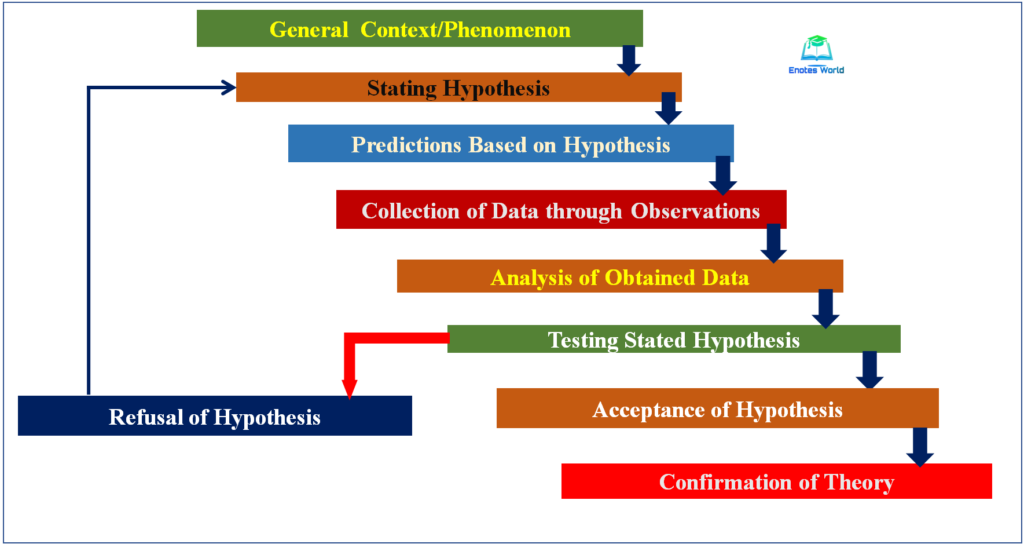| Learning Objective To explain hypothetico-deductive method of scientific study |
Meaning of Hypothetico-deductive Method
Hypothetico-deductive method also called H-D method is an approach to research or a method of construction of a scientific theory that will account for results procured through direct observation and experimentation and that will, through inference, forecast additional effects that can then be verified or disproved by empirical verification derived from other experiments.
An early or premature version of the hypothetico-deductive method was forwarded by the Dutch physicist Christiaan Huygens (1629–95). The method generally assumes that properly shaped theories are postulations and they are proposed to explain a set of observable data. According to him, such hypotheses cannot be decisively recognized and established until the consequences that rationally derived from them are confirmed and verified through further observations and experiments.
The hypothetico-deductive method is based on the idea of falsification, and it is an alternative to inductivism. The method looks theory as a deductive system in which particular empirical phenomena are explained by relating them to general principles and definitions.
The method treats theory as a deductive system in which particular empirical phenomena are explained by connecting them back to general principles and definitions. It assumes that the validity of theories is measured only by the exact light of their consequences or findings throw on previously unexplained phenomena or actual scientific problems.
Philosopher Karl Popper said that it is not possible to confirm a scientific theory correct by the way of induction because no evidence ensures that opposing facts or evidence will not be found. Instead, Karl Popper predicted that proper science or a scientific theory is accomplished by deduction. According to him, a scientific theory is based on deduction and it involves the process of falsification. Falsification is a particular specialized feature or attribute of hypothesis testing. It includes stating some output from theory and then finding opposing cases using experiments or observations. This methodology proposed by Popper is commonly known as the hypothetico-deductive method.
According to this method, the scientific inquisition proceeds by formulating a hypothesis and then falsified by vigorous tests on visible empirical data. Thus the hypothetico-deductive is one of the keystone foundations of scientific research and is considered as the only true scientific research method.
The hypothetico-deductive method unlike the deductive method provides more stress on the denial of the incorrect or unverifiable hypothesis and to set effort into forming the revised hypothesis, which is testable. Therefore, the hypothetico-deductive method proposes the ever-improving cycle of hypothesis formation that follows the unbroken cycle of refutation and revisions of the hypothesis unless the hypothesis is verified.
The hypothetico-deductive method confirms a theory when the prediction and observation gap is small and disconfirms when the gap is large. Most of the focuses on scientific methodology are to reduce the gap between predictions and observations.
Steps in Hypothetico-deductive Method
The hypothetico-deductive method begins with the postulation of the hypothesis that relies on general phenomena. From the stated hypothesis, some initial predictions are generated and these can be proved or disproved by the experimental process. These predictions must be intrinsically testable for the hypothetico-deductive methods to be a valid process.
Thus, the stated hypothesis must be testable and pragmatic. The proposed hypothesis is tested through analysis of the collected data from observation and other several data collecting techniques. If the hypothesis is refuted, then a revised hypothesis is formed and the same previous process is continued. If the hypothesis is confirmed, then the theory is confirmed. So, this method is said to be a scientific method of research. The following chart shows the process of hypothetico-deductive method of study.

The above chart shows the process of hypothetico-deductive method of scientific study. Somehow the process is parallel to the deductive study of scientific study. But the very significant break between these two methods occurs at the state of refusal of stated hypothesis. The deductive method is not in favor of suggesting the revision of the stated hypothesis and then re-conducting the hypothesis testing process. However, this method advocates for the revision of the hypothesis and re-operation of the hypothesis testing unless the hypothesis is verified and accepted.
Conclusion
The hypothetico-deductive method is the true scientific research method in which testable hypotheses can be set up and then they are justified with empirical data and observation. Falsification is the key context of this method. It involves a specific statement and then finding contrary evidence through experiments on observations. Under this model, a hypothesis is set to generate and predict some identical preconditions, the experiment is conducted and consequences are derived which are tested against the hypothesis. If the hypothesis is proved true, it becomes confirmed theory and if it is falsified we can again go for re-conduction of the observation and experimentation.